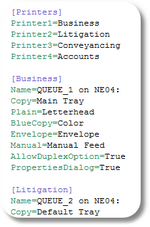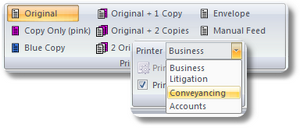A custom printing feature to simplify complex printing options.

Our customer uses many types of paper stock, in printers with varying features such as double–sided printing, stapling, and so on. We gave them a custom tab in Microsoft Word to organise the options into a set of standardized profiles.
This printing feature is implemented as a Microsoft Word add–in, with some extra tools for printer troubleshooting and discovery.

Our customer uses different coloured paper for various copies, so they can spot easily which copy goes to their customer, which copy goes on file, and which copy gets shredded. They have several printers of differing capabilities — some are colour, some can do double–sided, some will staple the document, and all are complicated.
The printers are configured in a configuration file stored on a shared drive. This allows the IT folks to add or update printers centrally, without having to visit every user. Printers are identified by business functions, and the configuration is defined in terms of business rules, making it easier to understand than specifying tray numbers.

The users select a printer by business function name, select a printing profile such as "two originals for the client and one office copy", and then hit the Print button. Because the options are presented in business terms, the users need less day–to–day support from the IT department.
Our customer has clerical policies to keep paperwork manageable. For example, when they send a document to a client it’s printed on letterhead, and the office file copy is printed on pink paper. Copies for other purposes are printed on other paper. They also have many printers with varying features such as double–sided printing, collation, and so on.

To print a document in accordance with the company’s standards, our customer first selects a printer appropriate to the relevant business function. The system then presents a set of print profiles that are available on the selected printer. Our customer chooses a profile and clicks the Print button.
The profiles are presented in business terms such as “one original and two copies”. The system works out the details of how to print the original on letterhead and the two copies on pink paper.
The motivation for this system was to save time and maximise efficiency.
Our customer’s corporate standards require that documents be printed on different paper stock depending on their purpose, and there are various standard combinations for different situations.
Our customer wanted to streamline the confusing and error–prone process of printing documents correctly according to these standards. Identifying printers by their technical names and fiddling around with printer options is not a good use of a lawyer’s time.
We developed a custom print feature that hides these details. The lawyers just select a business function and then select from a set of standardized print profiles. The system then prints the document on the correct paper stock and in the correct quantity. This is a classic case of adapting the software to fit the business process — too often it’s the other way round.
This system increased our customer’s productivity at a cost of just a few thousand dollars.
